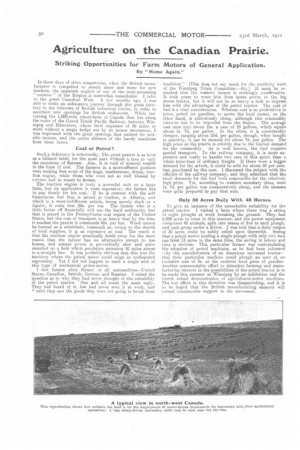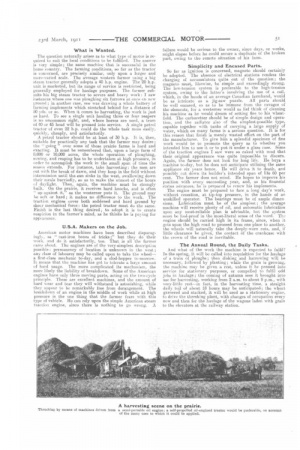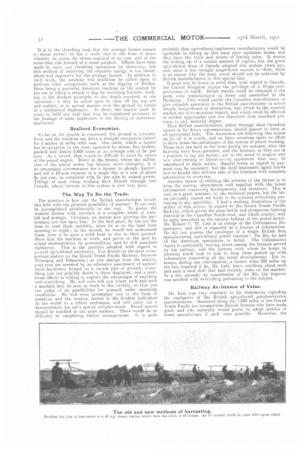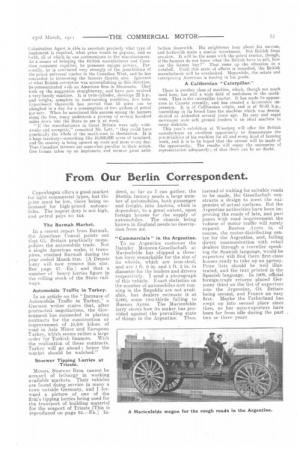Agriculture on the Canadian Prairie.
Page 4

Page 5

Page 6

Page 7

If you've noticed an error in this article please click here to report it so we can fix it.
Striking Opportunities for Farm Motors of General Application.
By "Home Again."
In these days of stern competition, when the British manufacturer is compelled to search more and more for new markets, the apparent neglect of one of the most-promising "corners " of the Empire is somewhat remarkable. 1 refer to the great Canadian West. A few months ago, .1 was able to make an exhaustive journey through this great territory in the interests of British industrial circles, in order to ascertain new openings for British endeavour. While traversing the 1,000-mile wheat-farm of Canada that lies along the route of the Grand Trunk Pacific Railway, between Winnipeg and Edmonton, where level expanses of 30 miles or more without a single hedge are by no means uncommon, I was impressed with the great openings that existed for suitable motors, and the entire absence of the handy machines from these farms.
Coal or Petrol?
Such a deficiency is noteworthy. The great prairie is as level as a billiard table, for the most part without a tree to vary the monotony of flatness. Also, it is void of mineral wealth in the form of coal. The farmers in a more-affluent position were making free avail of the huge, cumbersome, steam, traction engine while those who were not so well blessed by fortune had to resort to horses.
The traction engine is truly a powerful unit on a large farm, but its application is most expensive; the farmer has to pay dearly for his coal. If he is content with the soft bituminous fuel that is mined at Carbon, in Alberta, and which is a most-indifferent article, being merely slack or a lignite, it costa him 29s. per ton The farmer who is a little better off financially will use the hard anthracitic fuel that is mined in the Pennsylvania coal region of the United States, but the cost, of transport is so heavy that by the time it reached the prairie it commands 60s. per ton. Wood cannot be burned as a substitute, inasmuch as, owing to the dearth of local supplies, it is as expensive as coal. The result is that the traction engine practically holds sway for the mere reason that the farmer has no alternative except to use horses, and animal power is proverbially slow and quite unsuited on a field which perchance measures 10 miles across in a straight line. It, was perfectly obvious that this was the territory where the petrol motor could reign in undisputed supremacy. Yet I did not happen to meet a, single unit of this type of mechanical prime-mover. I met farmer after farmer of all nationalities—United States, Canadian, British, German and Russian. I raised the question as to why they had never thought, of the suitability of the petrol tractor. One and all made the same reply. They had heard of it, but had never seen it at work, and " until they saw the goods they were not going to break from tiadition." ',This does not say much for the publicity work of the Winnipeg Trials Committee.—En.] It must be remarked that the western farmer is strikingly conservative. It took years to wean him from horse power to the big steam tractor, but it will not be so heavy a task to impress him with the advantages of the petrol tractor. The cost of fuel is a vital consideration. Whereas coal is so prohibitive in price, petrol (or gasoline, to quote the local name), on the other hand, is ridiculously cheap, although this commodity likewise has to be imported from the States. The average cost runs into about 16s. a case of 10 gallons, which equals about Is. 7d. per gallon. In the cities, it is considerably cheaper, ranging about 10d. per gallon, though, when bought in quantity, it, can be secured for about 7d. per gallon. The high price on the prairie is entirely due to the limited demand for the commodity. As is well known, the fuel requires special transport. To the railway company, it is more expensive and costly to handle two cars of this spirit than a whole train-load of ordinary freight. If there were a bigger demand for the article, it could be sold for about 50 per cent. less, purchased by the case. I discussed the subject with the officials of the railway company, and they admitted that the small demands for the fuel were responsible for the relatively high price. Yet, according to western monetary ideas, even is. 7d. per gallon was comparatively cheap, and the farmers were quite prepared to pay that sum.
Only 50 Acres Daily With 40 Horses.
To give an instance of the remarkable suitability for the petrol tractor. I visited a farm where there was a string of eight ploughs at work breaking the ground. They had 8,000 acres to treat in this manner, and the power equipment comprised 40 animals, split into teams of five to each plough, and each group under a driver. I was told that a daily output of 30 acres could be safely relied upon therewith. Seeing that a petrol motor hauling a single plough with only two men can treat 15 acres in the same time, the saving in labour and time is obvious. This particular farmer was contemplating the adoption of petrol machines as he had been informed —by the manufacturers of an _American universal tractor— that their particular machine could plough an acre at an inclusive cost of 3s. at the existent local price of gasoline. Another commendable effort to stimulate farming and manufacturing interest in the possibilities of the petrol tractor is to be made this summer at Winnipeg by an exhibition and the fourth actual demonstration of agricultural-motor machines. The last effort in this direction was disappointing, and it is to be hoped that the British manufacturing element will extend considerable support to the movement.
What is Wanted.
The question naturally arises as to what type of motor is required to suit the local conditions to be fulfilled. The answer is very simple; the same machine that is successful in the home country. The farming conditions, so far as the tractor is concerned, are precisely similar, only upon a larger and more-varied scale. The average western farmer using a big steam tractor generally adopts a 40 h.p. engine. The 20 h.p. unit is marketed, but its range of service is restricted, being generally employed for haulage purposes. The farmer submits his big steam tractor to severe and heavy work : I saw instances where one was ploughing six furrows at once on new ground; in another case, one was drawing a whole battery of farming implements which stretched behind for a distance of 50 yds. or so. When it comes to harvesting, the work is just its hard. To see a single unit hauling three or four reapers is no uncommon sight, and, where horses are used, a, team of 40 or 45 head will be pressed into service. A single petrol tractor of even 22 h.p. could do the whole task more easily, quickly, cheaply, and satisfactorily.
A petrol tractor should be at least of 30 h.p. It. is, then, suitable for practically any task that the farmer may desire; the " going " over some of these prairie farms is hard and exacting. It must be remembered that, upon a large farm of 8,000 or 10,000 acres, the whole operation of ploughing, sowing, and reaping has to be undertaken at high pressure, in order to accomplish the work in the small span of time the season extends, For instance, take harvesting : the men are out -with the break of dawn, and they keep in the field without intermission until the sun sinks in the west, swallowing down their meals hurriedly, so as to make the utmost of the hours of daylight. Then, again, the machine must be strongly built. On the prairie, it receives hard knocks, and is often " up against it," as the westerner puts it. The ground may be soft or hard; it makes no difference to the work. The traction engines cover both soddened and hard ground by sheer mechanical force : the petrol tractor must du the same. Finish is the last thing desired; to adopt it is to create suspicion in the farmer's mind, as he thinks he is paying for appearance.
U.S.A. Makers on the Job.
American motor machines havo been described disparagingly, as " cast-iron boxes of tricks ;" but they do their week, and de it satisfactorily, too. That is all the farmer cares about. The engines are of the very-simplest description possible: permanency of location is unknown in the west; any class of labourer may he called upon to take the wheel-7 a first-class mechanic to.day, and a clod-hopper to-morrow. It means that the machine fias got to tolerate a large amount of hard usage. The more complicated its mechanism, the snore likely the liability of breakdown. Some of the American engines have only three moving parts, acting on the two-cycle principle. These are excellent machines, and the amount of hard wear and tear they will withstand is astonishing, while they appear to be remarkably free from derangement. The breakdown of an engine in the middle of work while at high pressure is the one thing that the farmer fears with this type of vehicle. Ho can rely upon the simple American dearn traction engine, since there is nothing to go wrung. A
failure would be serious to the owner, since days, or weeks, might elapse before he could secure a duplicate of the broken part, owing to the remote situation of his farm.
Simplicity and Encased Parts.
So far as ignition is concerned, magneto should certainly be adopted. The absence of electrical stations renders the charging of accumulators quite out of the ttuestion; the magneto must, likewise, be simple and exceedingly strong. The low-tension system is preferable to the high-tension system, owing to the latter's involving the use of a coil, which, in the hands of an average Canadian farmhand, would be as intricate as a jig-saw puzzle. All parts should be well encased, so as to be immune from the ravages of the elements, for a westerner would as lief think of cleaning his machine as he would dream of setting fire to his wheatfield. The carburetter should be of simple design and operation, and the radiator also of the simplest.possible type, capable together with tanks of carrying a large supply of water, which on many farms is a serious question. It is for this reason that finish is merely wasted effort on the part of the manufacturer. To give him a splendid specimen of fine work would be to promote the query as to whether you intended him to use it or to put it under a glass case. Some of the traction engines I saw were so caked with mild that their original appearance was quite impossible to discern. Again, the farmer does not look for long life. He buys a machine to-day, but he does not anticipate utilizing the same appliance six years hence. lie will drive it to death, and possibly cut down its builder's intended span of life 60 per cent. The farmer does not mind. Re hopes to improve his position with every succeeding year, and, as his finandal status advances, he is prepared to renew his implements.
The engine must be prepared to face a long day's work, without cessation, at tip-top pressure, in the hands of an unskilled operator. The bearings must be of ample dimensions. Lubrication must be of the simplest; the. average machine will receive plenty of oil, and automatic lubrication upon any most-reliable plan is advisable, but the sy.,stein must be fool-proof in the most-literal sense of the word. The engine should be carried high in its frame, since, when it gets upon the high road to proceed from one place to another, the wheels will naturally take the deeply-worn ruts, and, if little clearance be given, the contact of the crankcase with the crown of the road is inevitable.
The Annual Round, the Daily Tasks.
And what of the work the machine is expected to fulfill In the spring, it will be called into requisition for the haulage of a train of ploughs; then diskingand harrowing will be necessary, followed by planting; while the grain is growing, the machine may be given a rest, unless it be pressed into service for stationary purposes; or compelled to fulfil odd jobs in haulage; the coming of autumn sees it brought into use for harvesting, working from 2 a.m. to about 9 p.m., with very-little rest—in fact, in the harvesting time, a straight daily toil of about 18 hours may be anticipated-; the wheat garnered and stacked, it will be used as a stationary engine, to drive the threshing plant, with changes of occupation every now and then for the haulage of the wagons laden with grain to the elevaters at the railway station.
It is in the threshing task that the average farmer resorts to steam power ; he has a ready fuel in the form of straw whereby he raises the steam required at no cost, and at the same time rids himself of a waste product. Efforts have been made to carry out threshing operations by electricity, but this method of obtaining the requisite energy is too roundabout and expensive for the average farmer. In addition to such work, the machine will doubtless be called upon to perform other occupations, such as the digging of ditches, there being a powerful American machine on the market by the use of which a trench is dug by revolving buckets, working cm the dredger principle, to any depth required, at one operation : it may be called upon to clear off the top soil and stubble, or to spread manure over the ground by means of a mechanical implement. In short, the tractor must be ready to fulfil any task that may be considered necessary in the haulage of some implement or the driving of stationary appliances.
Realized Economies.
Se far as the prairie is concerned, the ground is tolerably level, and the machine can drive a straight continuous furrow for a matter of miles with ease. One outfit, which a farmer has in operation in the west, operated by steam, has broken, packed and disked 2.600 acres at an average cost of 5s, per acre. As a record, that would be difficult to excel by means of the petrol engine. Down in the States, where the utilization of the petrol motor has become more extensive, it is no uncommon circumstance for a farmer to plough, harrow, and roll a 10-acre expanse in a single day at a cost of about 2s. per acre, as compared with 5s. per acre by animal power. Tidings of such cheap working have filtered through into Canada, where interest in this system is now very keen.
The Way To Do the Trade.
The question is how can the British manufacturer invade this field with the greatest possibility of success? It can only be accomplished satisfactorily in one way. To pester the western farmer with circulars is a complete waste of time, ink and postage. Circulars, no matter how glowing the particulars, are lost upon him. In the first place, he has not the time to read them carefully, since he is on his land from morning to night; in the second, he would not understand them, even if he gave a solid hour or two to their perusal. Show him the maehine at work, and prove on the spot by actual demonstration its potentialities, and he will purchase rightaway. This is the practice adopted with regard to geeeral agricultural machinery. You detrain at the must-unimpartant station on the Grank Trunk Pacific Railway, between SVinnipeg and Edmonton; as you emerge from the station, your eyes are arrested by an extensive assortment of agricultural machinery housed on a vacant plot of ground ; everything you can possibly desire is there displayed, and a courteous official is willing to explain the advantages of anything and everything. lie will even tell you where such and such a machine may be seen at work in the vicinity, so that you can judge of its possibilities for yourself under operating conditions. He will even accompany you to the farm in questien, and the western farmer is the kindest individual in the world to a fellow craftsman and will carry out a demonstration for one's special enlightenment. Petrol motors should be handled in the same matinee. There would be no difficulty in completing similar arrangements. It is quite
probable that agricultural-implement manufacturers would be agreeable to taking up this issue upon equitable terms, and they have the ways and means of forcing sales. It. means the locking up of a certain amount of capital, but, the great agricultural firms of Canada adopted this system years ago, and, since it has brought magnificent success to them, there is no reason why the same result should not be achieved by British manufacturers in this special line. It must also be borne in mind that, with regard to Canada, the United Kingdom enjoys the privilege of a 10-per-cent. preference in tariff. Better results could be obtained if the parts were manufactured at home and assembled in the Dominion. This would enable the Canadian manufacturer to give valuable assistance to the British manufacturer in minor details, insignificant in themselves, but which to the western market are of trsmendous import, and which could be effected at neither appreciable cost nor departure from standard patterns to any material degree. Then British manufacturers, either through their Canadian agents or by direct representation, should appear in force at all agriculural fairs. The Americans are following this action up for all it is worth, and on these occasions spare no effort to drive home the advantages of the system of petrol working. These faire are held in the west during the autumn, after the harvests have been garnered, and the farmers, as they are in a position to lay out money, are in the mood to acquire any new time-cutting or labour-saving appliances that may be introduced to their notice. Special terms in regard to payment may be necessary, but the local implement agent knows how to handle this delicate side of the business with complete satisfaction to everyone.
Another means of enlisting the interest of the farmer is to keep the railway department well supplied with the latest information concerning developments, and literature. This is met, in a great measure, by the technical papers, but the latter obviously cannot set forth in its columns everything pertaining to ally speciality. I had a striking illustration of the utility of this action, in regard to the Grand Trunk Pacific Railway, which serves the most-fertile and prosperous *ming districts in the Canadian North-west, and which country may be aptly described as the natural habitat of the petrol motor. Mr. Robert C. W. Lett is in charge of the Colonisation Department., and this is regarded as a bureau of information. He did not possess the catalogue of a single British firm manufacturing agricultural petrol tractors ! On file, he had all the American specialities in detail. The Colonisation Agent is continually moving about among the farmers served by his railway, and the farmers with whom he keeps in personal touch look to him to keep them posted up with information concerning all the latest developments. For instance, during our conversation, a farmer some 500 miles up the line inquired if he, Mr. Lett, knew anything about such and such a seed drill that had recently come on the market. In a few seconds, by consultation of the file, the inquirer was satisfied with everything pertaining to the subject.
Railway As,istance of Value.
Mr. Lett was very emphatic in his statements regarding the negligence of the British agricultural gasoline-tractor manufacturers. Scattered along the 1,000 miles of the Grand Trunk Pacific are innumerable British farmers who have made good, and who naturally would prefer to adopt articles of home manufacture if such were possible. Moreover, the
Colonisation Agent is able to ascertain precisely what typo of implement is required, what price would be popular, and so forth, all of which he can communicate to the manufacturers. As a moans of bringing the British manufacturer and Canathan consumer together, he possesses unique powers. Personally, he is convinced very strongly of the possibilities of the petrol universal tractor in the Canadian West, and he has succeeded in interesting the farmers therein also. Ignorant of what British enterprise was accomplishing in this direction, he communicated with an American firm in Minne.sola. They took up the suggestion straightaway, and have now evolved a very-handy machine. It is twin-cylinder, develops 22 h.p., and weighs, complete in road-running condition, five tons. Experiment therewith has proved that 15 acres can be ploughed in a day for a consumption of two gallons of petrol per acre. When he mentioned this success among the farmers along the line, many undertook a journey of several hundred miles down into the State to see it at work.
" If the manufacturers in Great Britain were only wideawake and energetic," remarked Mr. Lett, " they could have practically the whole of the north-west to themselves. It is a huge territory—something like 16,000,000 acres of farmland, and the country is being opened up more and more every day. Then Canadian farmers are somewhat peculiar in their action. One farmer takes up an implement. and secures great satis faction therewith. His neighbours hear about his success, and forthwith make a similar investment. But British firms are slow. It will be the same with the petrol tractor, though, if the farmers do not know what the British have to sell, how can the farmer buy?" That sums up the situation in a. nutshell. Until this state of affairs is remedied, the British manufacturer will be overlooked. Meanwhile, the astute and enterprising American is forcing in his goods.
A Californian " Caterpillar."
There is another class of machine, which, though not much used here, has still a wide field of usefulness in the northwest. That is the caterpillar tractor. It has made its appearance in Canada recently, and has created a favourable impression. It is of Californian origin, and is of 40-50 h.p., resembling in its broad lines the machine which was demonstrated at -Aldershot several years ago. Its easy and rapid movement over soft ground renders it an ideal machine in many districts. This year's exhibition at Winnipeg will offer the British manufacturer an excellent opportunity to demonstrate the potentialities of his machine for all and every kind of farming work, and it is to he hoped that the utmost will be made of the opportunity. The results will repay the enterprise of representation adequately ; of that there can be no doubt.






















